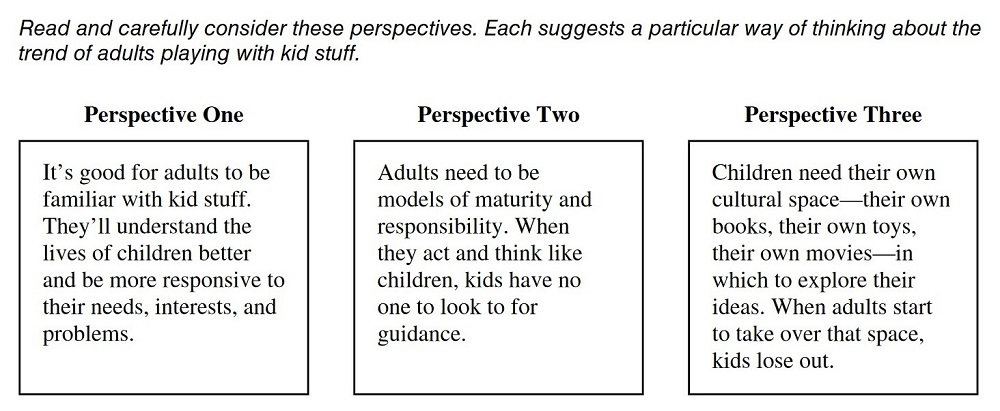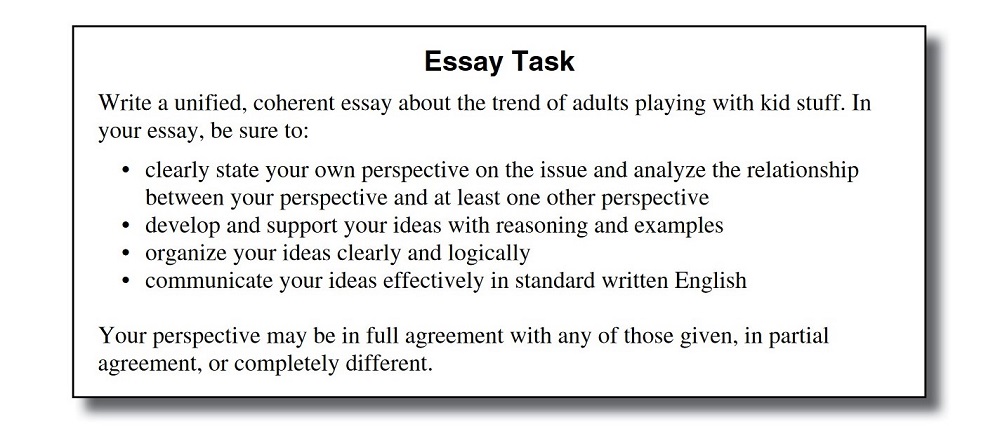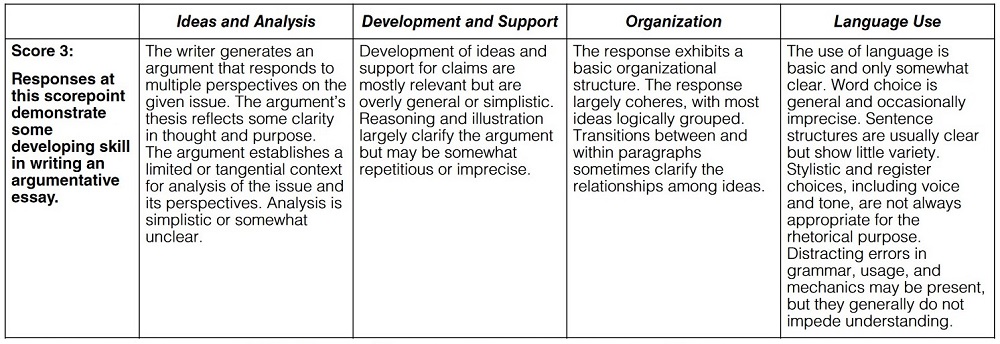Below are sample essays and score explanations to the full-length Writing test of the previously released ACT from the current 2020-2021 “Preparing for the ACT Test” (form 1874FPRE) free study guide available here from ACT for free. For more general tips and strategies for the ACT writing test, click here.
The ACT Writing test explained below begins on page 53 of the guide. Please note that the 2020-2021 guide features the same practice test as the 2019-2020 guide. Other answer explanations in this series of articles:
- English Answer Explanations from 2020 ACT Practice Test
- Math Answer Explanations from 2020 ACT Practice Test
- Reading Answer Explanations from 2020 ACT Practice Test
- Science Answer Explanations from 2020 ACT Practice Test
- Writing Test Sample Essays from 2020 ACT Practice Test (this article)
When you’re finished reviewing this official practice ACT test, start practicing with our own 10 full-length practice ACT tests—absolutely free during the pandemic.
ACT Writing Test Sample Essays and Explanations



Remember that you have only 40 minutes to familiarize yourself with the prompt, plan your essay, and write it out. It is recommended that you take no more than 10 minutes to plan your essay, so that you have the rest of the time to write and review it. The test booklet includes blank pages for you to use when planning your essay. These blank pages are not scored; only the lined pages on which you write your essay will be scored.
Well-Written Essay Sample 6/6
First, let’s look at a sample essay which would likely receive the highest possible score (a 6 in all categories, which results in a final ACT Writing score of 12). A top-scoring essay will align with the following ACT scoring rubric descriptions:

In the past, there was a clear delineation between the leisure activities of adults and children, but these days that line is not as clear. Increasingly, adults are spending time engaging with children’s entertainment, like video games, animated films, and comic books. But despite what might be seen as troubling consequences of this trend, a deeper examination reveals it to be benign or even beneficial.
One common line of argument suggests that adults who play with “kid stuff” are displaying signs of immaturity. But this is an overly simplistic reading, and in many cases one which displays undercurrents of elitism. For instance, grouping all animated films or TV programs together fails to account for the wide variety that exists within that genre. Longstanding shows like “Family Guy” have always been aimed at an older audience, and newer programs like “Bojack Horseman” have received critical acclaim for their sensitive handling of complicated, adult topics. To suggest that watching these shows is no different from, say, watching “Teletubbies” is to create a false equivalence.
It is also worth considering the positive effects of “play” in children and seeing what relevance they may have to adult life. Play is both an successful stress-reducer and an outlet for creativity. Additionally, many toys are designed with an educational component in mind. There is no reason why these upsides to children’s entertainment should be denied to adults, many of whom lead stressful lives. Playing video games after a long day of work could even be seen as a healthy activity, since they are working to mitigate the unhealthy effects of long-term stress.
In addition to possible personal benefits, there are potential interpersonal benefits too. Adults who are aware of trends in children’s entertainment may find it easier to relate to younger generations. Recently, Congresswoman Alexandria Ocasio-Cortez made headlines when she used a live session of the popular videogame “Among Us” to educate younger Americans about voting rights and registration. Although she could have delivered the same information in a more “grown-up” setting, her embracing of an element of youth culture made the message more powerful.
It is clear that toys aren’t “just for kids” anymore; after close examination, it is equally clear that this is not a matter for concern. Although the description of “kid stuff” is itself reductive, even putting that aside there are personal benefits to be had from engaging with it, not to mention the possibility of greater cross-generational communication. This blurring of difference between adults’ and children’s entertainment may be a relatively new phenomenon, but its novelty does not signal a problem. Rather, it offers exciting new possibilities for all of us, whatever our age.
Sample Essay Score Explanation
Let’s look at how this essay aligns with the rubric descriptions for a score of 6 in each domain. Text in quotes comes from the rubric, italicized text comes from the student’s essay.
Ideas and Analysis:
“The writer generates an argument that critically engages with multiple perspectives on the given issue. The argument’s thesis reflects nuance and precision in thought and purpose.”
The student’s thesis is easily located as the last sentence of the introductory paragraph: But despite what might be seen as troubling consequences of this trend, a deeper examination reveals it to be benign or even beneficial. This thesis is clear and specific and signals what ground the essay will cover.
What gives this thesis “nuance and precision”? It is the way the student acknowledges that the evidence can be read in multiple ways (troubling, benign, beneficial) but nonetheless commits to one perspective (in this case, that the trend is on the whole a good thing).
“The argument establishes and employs an insightful context for analysis of the issue and its perspectives. The analysis examines implications, complexities and tensions, and/or underlying values and assumptions.”
Each of the essay’s body paragraphs takes a different approach to analysis. The 2nd paragraph (One common line of argument…) attacks one of the provided perspectives by arguing that it is based on faulty “underlying values and assumptions.” We can see this in the second sentence where the student calls the premise an overly simplistic reading and calls out undercurrents of elitism.
The 3rd paragraph (It is also worth considering…) brings in a wholly new perspective which, again, questions the underlying assertion of play as an activity only suited for kids.
The 4th paragraph (In addition to possible…) is the most straightforward, simply presenting one of the given perspectives, but using a strong, specific example (Recently, Congresswoman…) to drive home the author’s point.
Development and Support:
“Development of ideas and support for claims deepen insight and broaden context. An integrated line of skillful reasoning and illustration effectively conveys the significance of the argument. Qualifications and complications enrich and bolster ideas and analysis.”
Notice how the student’s examples “broaden [the] context” of their argument. In the 3rd paragraph, for instance, the student uses their argument that play has beneficial effects to suggest a possible widespread benefit to adults’ longterm health. Suddenly, the issue under discussion is not limited to the world of children’s playtime and takes on potentially more serious implications.
In the 4th paragraph, the student’s example of AOC using “Among Us” to to raise awareness of voting rights brings a wider political view to the issue under discussion. Again, the context has been broadened; suggesting political implications also strengthens “the significance of the argument.”
Organization:
“The response exhibits a skillful organizational strategy. The response is unified by a controlling idea or purpose, and a logical progression of ideas increases the effectiveness of the writer’s argument.”
The writer uses a five-paragraph essay format, but the paragraphs flow organically. Notice how the body paragraphs both illustrate the thesis, and build on one another. The student begins by examining what might be seen as troubling consequences, namely that adults who play with “kid stuff” are displaying signs of immaturity.
The next two paragraphs then develop the idea that a deeper examination reveals it to be benign or even beneficial. First, the student suggests that there are overlooked personal benefits of play (it is a successful stress-reducer and an outlet for creativity).
Then, the following paragraph proposes wider societal benefits (notice the parallelism between possible personal benefits and potential interpersonal benefits).
“Transitions between and within paragraphs strengthen the relationships among ideas.”
Clunky transitional language (firstly, secondly, in conclusion, etc.) is avoided, but the paragraphs flow logically. The organization within paragraphs is strong: let’s use the 4th paragraph as an example.
First, there is a transition sentence (In addition to possible personal benefits) which both refers back to the previous paragraph and sets a course for the current line or argument. Then there is a clear topic sentence (Adults who are aware of trends in children’s entertainment may find it easier to relate to younger generations), which describes what will follow.
Next, there is a specific example to illustrate the topic sentence. Finally, the student re-contextualizes their example by explaining why it is relevant (her embracing of an element of youth culture made the message more powerful).
Language Use:
“The use of language enhances the argument. Word choice is skillful and precise. Sentence structures are consistently varied and clear. Stylistic and register choices, including voice and tone, are strategic and effective.”
There are no significant language or grammar problems. A wide range of vocabulary (benign, phenomenon, mitigate) is deployed to strong rhetorical effect. The student avoids direct repetition when possible. Sentence length varies; commas, apostrophes, and semicolons are used correctly. All of this indicates a strong command of written English.
The student uses appropriate academic language and a formal tone. Notice how the student puts the phrases “kid stuff” and “just for kids” in quotes to indicate that the informality of the language is not their own. “Stuff” is a vague word that should be avoided, but here it is clear that the student is not an unimaginative writer, just quoting the prompt.
ACT 2020 Practice Test Sample Essay – Score 3/6
Mediocre Essay Sample
Now, let’s look at a sample essay which would likely receive middling scores (a 3 in all categories, which results in a final ACT Writing score of 6). A mid-scoring essay will align with the following ACT scoring rubric descriptions:

There are many ideas about adults playing with “kid stuff” like toys and games. Some people think that its a bad thing and some people think that its a good thing. Like how it can help adults understand kids lives better, but also kids maybe feel that adults shouldn’t try so hard. So there are a lot of perspectives.
Toys are meant for kids and teenagers, not really for adults. For example, dolls are made for younger children to play with because they have more imagination. Adults are supposed to grow up so if they are still playing with dolls it might mean they are not growing up. Adults usually have less imagination too, so probably they won’t really get anything out of the experience of playing with dolls anyway.
Because toys are meant for children it can feel invasive of the children’s “cultural space” if adults are playing with them too. For example, it is really awkward when my parents try to relate to my friends interests. Even if they try very hard, they don’t really get what we are intrested in. Actually the more they try the more awkward it becomes. So even though you could say that adults should try to learn about “kid stuff” to relate to them, it seems like maybe they still can’t relate, so it’s not worth it.
One reason that adults might still play with toys is that it reminds them of their childhood. Thinking about happy memories could make them feel good if their life is hard right now. In this case, maybe playing with toys isn’t so bad. But if they do it too much it seems like they are just trying to avoid the problems in their life. This is not a good role model for adults to be showing kids.
In conclusion, we can see there are a wide range of views about adults who play with toys. There are some possible good things about it, for example if it helps them relate to young people or if it helps them remember their childhood. But there are also bad sides because playing with toys might mean, adults are not acting grown up enough. Because there are good and bad affects of adults playing with toys, this issue will probably still be debated for a long time to come.
Sample Essay Score Explanation
Let’s look at how this essay aligns with the rubric descriptions for a score of 3 in each domain. Text in quotes comes from the rubric, italicized text comes from the student’s essay.
Ideas and Analysis:
“The writer generates an argument that responds to multiple perspectives on the given issue. The argument’s thesis reflects some clarity in thought and purpose.”
The student’s thesis appears to be: So there are a lot of perspectives. Although it gives an indication of what the essay will be about, it is a very weak thesis. It acknowledges many perspectives, but does not weigh the value of each; the student has failed to define their own position.
“The argument establishes a limited or tangential context for analysis of the issue and its perspectives. Analysis is simplistic or somewhat unclear.”
The essay’s body paragraphs all take a similar approach to analysis. Let’s use the 2nd paragraph as an example. First, they present an argument as a statement of fact (Toys are meant for kids and teenagers, not really for adults). Again, notice the lack of the student’s personal perspective.
The student uses an example (dolls are made for younger children…) but does not fully explore its implications. In attempting to contextualize the example, the student simply repeats the main argument (Adults are supposed to grow up so if they are still playing with dolls it might mean they are not growing up.)
The student concludes by making a claim (Adults usually have less imagination) that is unsupported. They do not anticipate or rebut any assertions that might contradict their claim.
Development and Support:
“Development of ideas and support for claims are mostly relevant but are overly general or simplistic. Reasoning and illustration largely clarify the argument but may be somewhat repetitious or imprecise.”
Although each paragraph attempts to consider a different perspective, the writer’s own ideas are left unexplored. The student makes a series of small points, but fails to gather them together to support a larger claim.
The author’s examples are generally relevant, but the reader must infer their significance, which weakens their usage. Consider the 3rd paragraph, when the student uses an example from their own life (it is really awkward when my parents try to relate to my friends interests.)
Instead of using this example to look at the larger context of parent-child relations as it might relate to the topic at hand, the student reinforces the personal quality of the example: Even if they try very hard, they don’t really get what we are intrested in. The example thus comes off as an individual gripe rather than an illustration of a larger argument.
Organization:
“The response exhibits a basic organizational structure. The response largely coheres, with most ideas logically grouped.
The student has organized their essay using a traditional five-paragraph structure, which brings some general order to their ideas. But there is very little attention to the relationship between paragraphs, which seem to exist in isolation.
“Transitions between and within paragraphs sometimes clarify the relationships among ideas.”
The organization within paragraphs is also somewhat unclear—for instance, in the 4th paragraph. The final sentence (This is not a good role model for adults to be showing kids) seems to be introducing a new line of argument, but it is not connected the sentences which precede it. The lack of a transition weakens the significance of this argument.
Language Use:
“The use of language is basic and only somewhat clear. Word choice is general and occasionally imprecise. Sentence structures are usually clear but show little variety.”
The author uses a limited vocabulary; they overuse modifiers like really and maybe and the word choice is repetitive.
Sentence structure is occasionally varied but often somewhat awkward: Adults usually have less imagination too, so probably they won’t really get anything out of the experience of playing with dolls anyway. This sentence could be rendered more clearly, for instance: Because adults usually have less imagination, they are unlikely to have a valuable experience when playing with dolls.
“Stylistic and register choices, including voice and tone, are not always appropriate for the rhetorical purpose. Distracting errors in grammar, usage, and mechanics may be present.”
There are spelling and grammar errors (affect instead of effect, intrested instead of interested, improper apostrophe and comma usage) which indicate a lack of confidence in proper use. Some language is overly general, imprecise, or inappropriate (the use of get instead of understand; beginning a sentence with Like).



Leave A Comment